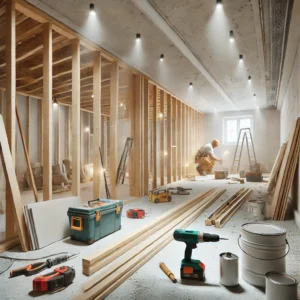
Transforming a basement can unlock valuable space in a home, providing opportunities for recreation, storage, or even rental income. Basement renovation services offer tailored solutions that enhance both functionality and aesthetics, making this often-overlooked area a central hub of activity.
Many homeowners seek to capitalize on their basement’s potential, whether for a cozy family room, a private gym, or a guest suite. Professional renovation services ensure the project adheres to local regulations while addressing potential moisture issues, insulation, and proper lighting.
Investing in basement renovations not only improves living space but can also increase the property value. Understanding the benefits and options available can help homeowners make informed decisions about how to best utilize their basements.
Planning Your Basement Renovation
Planning a basement renovation involves several critical steps that lay the groundwork for a successful project. It requires careful assessment of the existing space, clear identification of renovation goals, and thorough budgeting.
Assessing Your Space
Before beginning any renovations, it is essential to evaluate the current state of the basement. This includes checking for moisture issues, structural integrity, and ceiling height. Any existing plumbing or electrical systems should also be noted, as these can impact the design.
A thorough inspection can highlight areas that require repair and aspects that can be utilized in the renovation. Taking accurate measurements is necessary to develop a functional layout. Homeowners should consider the available natural light and ventilation options as well.
Defining Your Renovation Goals
Clearly defining renovation goals is crucial. Homeowners should decide whether the renovation will serve as a living space, recreation area, or a rental unit.
Setting specific objectives helps in prioritizing elements like design style, functionality, and aesthetic appeal. For instance, a family might want a playroom, while an individual might seek a home office. Discussing these goals with family members can ensure that the renovation meets everyone’s needs.
Budgeting and Financing
Creating a detailed budget is a fundamental aspect of planning a basement renovation. Homeowners should account for all expenses, including materials, labor, permits, and unexpected costs. It is wise to set aside an additional 10-20% for unforeseen issues that may arise during construction.
Exploring financing options can also facilitate the process. Homeowners may consider personal loans, home equity lines of credit, or renovation-specific loans. Researching and comparing interest rates and terms can help in making the best financial decision.
Executing the Renovation
Executing a basement renovation entails careful planning and execution. Key aspects include selecting the right contractors, making thoughtful design choices, adhering to building codes, and managing the project timeline stringently.
Selecting Contractors
Choosing a reliable contractor is critical. Homeowners should start by gathering recommendations from friends, family, or online reviews.
Key questions to ask:
- What is your experience with basement renovations?
- Can you provide references from past clients?
- What is your estimated timeline for the project?
Discussing budgets upfront ensures clarity on costs. It’s advisable to get multiple bids to compare services and pricing. Effective communication during the project helps avoid misunderstandings.
Design and Layout Considerations
A well-thought-out design maximizes space utility. Homeowners should consider their specific needs, whether it’s a guest room, home office, or entertainment area.
Important factors to consider:
- Ceiling height: Ensure the space feels open.
- Lighting: Incorporate both natural and artificial light sources.
- Access: Plan for comfortable movement and access to utilities.
Utilizing software or 3D modeling can visualize the layout, aiding decision-making.
Materials and Building Codes
Using appropriate materials is essential for safety and durability. Homeowners should select moisture-resistant materials to prevent mold growth. Commonly used materials include:
- Drywall: Moisture-resistant or mold-resistant types are preferable.
- Flooring: Vinyl or tile is often recommended for ease of maintenance.
- Insulation: Proper insulation helps regulate temperature.
Building codes vary by location. Homeowners should check local codes regarding permit requirements and adhere to safety standards. Consulting with an experienced contractor can ensure compliance.
Project Timeline and Milestones
Establishing a clear timeline is vital for project success. Homeowners should collaborate with contractors to set realistic milestones.
Typical phases include:
- Planning: Finalizing designs and obtaining permits.
- Demolition: Clearing the space for renovation.
- Construction: Structural changes and installations.
- Finishing: Final touches and inspections.
Regular updates from the contractor help keep the project on track. Adjustments may be necessary, but having a timeline helps manage expectations.
Buy Copper Stock: Key Insights for Investing in a Promising Market
Investing in copper stock can be a strategic move for those looking to diversify their por…